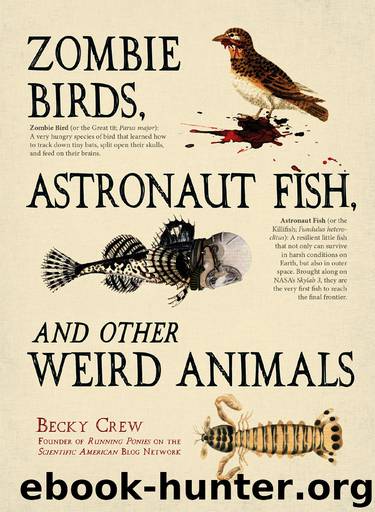Zombie Birds, Astronaut Fish, and Other Weird Animals by Becky Crew

Author:Becky Crew [Crew, Becky]
Language: eng
Format: epub, azw3, mobi
ISBN: 978-1-4405-6335-5
Publisher: F+W Media
Published: 2012-05-17T16:00:00+00:00
Microraptor Shows Its True Colors
MICRORAPTOR
“Strip-o-gram!”
“He’s here! He’s here! He’s—Oh.”
“You’re disappointed?”
“Well I was kind of hoping for someone a little more, I don’t know, colorful. You’re sleek and sophisticated, I’ll give you that, but this is a hen’s night, not a fucking board meet—Oh my.”
“What?”
“Your feathers just caught the light and look, I’ve got goosebumps … Why aren’t you dancing!”
IN RECENT YEARS, SCIENTISTS have been developing new techniques that allow them to observe the composition of a fossilized feather down to its very molecules, which means we can finally discover the colors of the earliest birdlike creatures on Earth. In early 2012, researchers led by evolutionary biologist Ryan Carney from Brown University discovered that the feathers of the iconic birdlike dinosaur Archaeopteryx were structurally identical to those of modern birds. Which is pretty incredible, considering Archaeopteryx is 150 million years old.
The study of fossilized melanosomes—pigment granules that contain melanin, the most common light-absorbing pigment that gives skin, feathers, hair, eyes, scales, and certain internal membranes their color—is very young. Up until 2006, researchers had been misidentifying fossilized melanosomes as bacteria due to their similar, sausage-like shape. But then molecular paleobiologist Jakob Vinther from Brown University identified the presence of ancient melanosomes in the ink sac of a fossilized squid, which opened up a whole new chapter in the study of extinct birds and feathered dinosaurs.
In January 2012, Vinther and Carney published a paper in Nature Communications describing the results of their examination of the molecular structure of a fossilized Archaeopteryx feather. The well-preserved middle-wing feather also happened to be the first Archaeopteryx specimen ever described, unearthed in 1861 by paleontologist Hermann von Meyer near Solnhofen in Germany. Using a method based on the one Vinther had used years earlier, and a highly powerful type of scanning electron microscope at the Carl Zeiss Laboratory in Oberkochen, Germany, the researchers figured out how to image individual one-micron-long melanosomes. (There are 25.5 microns in one thousandth of an inch.) By comparing these melanosomes to those in the feathers of eighty-seven modern bird species, the biologists concluded that their Archaeopteryx feather was likely to have been black, with a 95 percent certainty.
Because black pigmentation is packed with melanin, which is a relatively robust polymer known to make the keratin in feathers thicker and around 40 percent harder, the researchers suggested that this meant Archaeopteryx was a well-equipped flyer. Filled with tough, black pigment, the flight feathers were likely protected against the motion of repetitive flight and the air particles that would continuously whoosh past. So Archaeopteryx had strong, durable feathers, but what Carney and Vinther’s research couldn’t answer was the question of whether it flew using powered flapping or simply gliding.
Just a few months after this paper was published, a separate research team published the results of an investigation into the color of Microraptor’s plumage. Microraptor was an exquisitely feathered, magpie-sized dinosaur with four wings and a long plume of tail feathers, living 130 million years ago in the region that is now northeastern China.
Download
Zombie Birds, Astronaut Fish, and Other Weird Animals by Becky Crew.epub
Zombie Birds, Astronaut Fish, and Other Weird Animals by Becky Crew.azw3
Zombie Birds, Astronaut Fish, and Other Weird Animals by Becky Crew.mobi
This site does not store any files on its server. We only index and link to content provided by other sites. Please contact the content providers to delete copyright contents if any and email us, we'll remove relevant links or contents immediately.
Sapiens: A Brief History of Humankind by Yuval Noah Harari(13036)
The Tidewater Tales by John Barth(12026)
Do No Harm Stories of Life, Death and Brain Surgery by Henry Marsh(6332)
Mastermind: How to Think Like Sherlock Holmes by Maria Konnikova(6224)
The Thirst by Nesbo Jo(5778)
Why We Sleep: Unlocking the Power of Sleep and Dreams by Matthew Walker(5636)
Sapiens by Yuval Noah Harari(4528)
Life 3.0: Being Human in the Age of Artificial Intelligence by Tegmark Max(4492)
The Longevity Diet by Valter Longo(4443)
The Rules Do Not Apply by Ariel Levy(3897)
The Immortal Life of Henrietta Lacks by Rebecca Skloot(3820)
The Body: A Guide for Occupants by Bill Bryson(3789)
Why We Sleep by Matthew Walker(3767)
Animal Frequency by Melissa Alvarez(3750)
Yoga Anatomy by Kaminoff Leslie(3696)
Barron's AP Biology by Goldberg M.S. Deborah T(3628)
The Hacking of the American Mind by Robert H. Lustig(3575)
All Creatures Great and Small by James Herriot(3506)
Yoga Anatomy by Leslie Kaminoff & Amy Matthews(3392)
